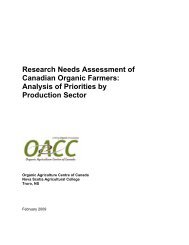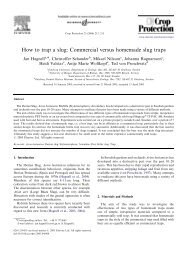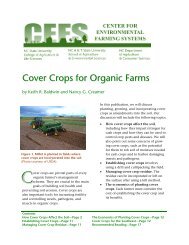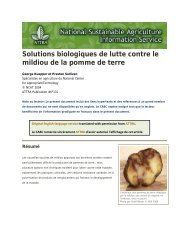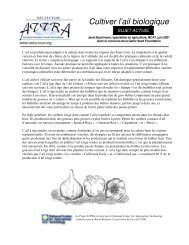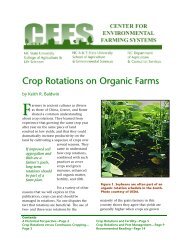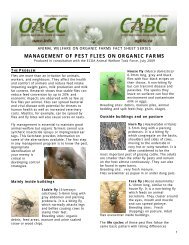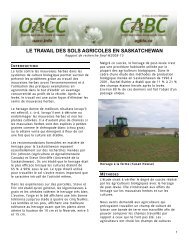Sweet potato: organic production - Centre d'agriculture biologique ...
Sweet potato: organic production - Centre d'agriculture biologique ...
Sweet potato: organic production - Centre d'agriculture biologique ...
Create successful ePaper yourself
Turn your PDF publications into a flip-book with our unique Google optimized e-Paper software.
The National Agricultural Statistics Service (NASS) reports commercial sweet<strong>potato</strong> acreage in ninestates for 2002 and 2003, ranging from about 40,000 acres planted in North Carolina down to 500 acresin Virginia. Louisiana, Mississippi, and California also report significant acreages. New Jersey is thenorthernmost Atlantic Seaboard state reporting significant commercial <strong>production</strong>. Varieties such as‘Georgia Jet’ can be raised in home gardens in the North. Production figures have varied little fromyear to year since the 1980s, although the U.S. population has grown by a third. This amounts, statistically,to a decline in U.S. per capita consumption that would have appeared more dramatic exceptfor expanding exports (3) and USDA purchases for donation to domestic food assistance programs.(4)Statistics for <strong>organic</strong> <strong>production</strong> are not yet available from NASS.(5)Canada and the United Kingdom are the main trading partners with the U.S. The North Carolina<strong>Sweet</strong><strong>potato</strong> Commission considers exports a “small but viable market.” China is the largest competitorand also represents a threat to U.S. domestic markets. Cost competitive shipping challenges remainto be resolved. Fuel charges and hurricane damage hurt Georgia shippers in 2004.(3)MarketsProcessingAccording to the grocery manager at Ozark Natural Foods (ONF) in Fayetteville, Arkansas, canned<strong>organic</strong> sweet<strong>potato</strong>es are packed and shipped from Oregon (where manufacturing facilities are moreconveniently located than in Southern California). ONF does not stock any <strong>organic</strong> frozen sweet<strong>potato</strong>products at this time. Organic sweet<strong>potato</strong> baby food sold through an Internet shopping service(ShopNatural.com) is supplied by the Tucson Natural Foods Warehouse, only a short trucking distancefrom the <strong>organic</strong> sweet<strong>potato</strong> fields of California.Other value-added <strong>organic</strong> sweet<strong>potato</strong> products include flour and pancake mixes from Bruce Foodsand sweet<strong>potato</strong> chips by Terra. Some East Coast restaurants—especially in New York and Florida—now feature sweet<strong>potato</strong> fries, most likely made on-site from boniato or Jersey types. The NationalAeronautic and Space Agency (NASA) is researching sweet<strong>potato</strong> breakfast cereal.(6)Many canneries processing conventionally-grown sweet<strong>potato</strong> are located in eastern Louisiana. TheMississippi <strong>Sweet</strong><strong>potato</strong> Growers Association began a relationship in 1995 with Glory Foods of Columbus,Ohio, contracting for 1,000 acres of <strong>production</strong> to supply Chicago markets. Products includedsweet<strong>potato</strong> fries. (See www.milewis.com/sweet<strong>potato</strong>fund/history.) White <strong>potato</strong> (Solanum tuberosum)processers with excess capacity due to a recent downturn in demand are now shifting to sweet<strong>potato</strong>products.In January of 2004, capitalizing on interest in convenience foods, the Mississippi Land, Water, andTimber Board agreed to put up two-fifths of the cost of building a $5 million plant in Vardaman,Mississippi, to produce “fresh-cut” and “frozen-cut” sweet<strong>potato</strong> products, contracting with nearbyconventional growers. Ninety percent of Mississippi commercial sweet<strong>potato</strong> acreage (3,500 acres in2003) lies within a 30-mile radius of Vardaman. (The grant is contingent upon sweet<strong>potato</strong> farmersin two counties raising an additional $3 million.) In April 2004 the Arkansas Rural Enterprise Centerannounced plans for a sweet<strong>potato</strong> processing storage center in the Arkansas Delta counties, whereabout 1,200 acres of sweet<strong>potato</strong> are harvested annually, and unemployment rates are chronicallyhigh.Small quantities of fresh-dug sweet<strong>potato</strong>, both conventional and <strong>organic</strong>, find local buyers throughoutthe South, especially at farmers’ markets. Oklahoma Cooperative Extension recommends Pick-Your-ATTRA//SWEETPOTATO ORGANIC PRODUCTION PAGE 3
Own as a marketing strategy. (See http://osuextra.com/pdfs/F-6022web.pdf.) An Internet search turnedup several hundred vendors selling fresh sweet<strong>potato</strong>es (mostly non-<strong>organic</strong>) on-line.Fresh produceU.S. No. 1s and 2s are the sweet<strong>potato</strong> grades intended for fresh produce markets. Jumbos, cuts, cracks,and splits are considered culls. Although root length and diameter may be consistent with U.S. grades1 or 2, roots are frequently omitted from the premium grades due to damage caused either by soildwellinginsects feeding on the roots or by rough handling at harvest or during sorting and grading,which results in “skinning.” These types of damage affect appearance, and feeding holes and skinningmay lead to secondary infections by pathogens in storage. Overfertilization, thin (nonuniform) stands,or failure to harvest at the right time can cause jumbos. Skinning occurs because the outer layer ofa sweet<strong>potato</strong> is not bound as tightly to the flesh as that of a white <strong>potato</strong>. Louisiana growers don’tseem to have as much of a problem with skinning, perhaps because of their siltier soils.(6).Unfilled nichesThere may be unfilled marketing niches for the dry-fleshed sweet<strong>potato</strong> types preferred in Asiancuisines and in gourmet markets as year-around grill food. <strong>Sweet</strong><strong>potato</strong>es, high in minerals andvitamin A, can be marketed as a “health food.” A baked sweet<strong>potato</strong> makes a satisfying entrée for avegetarian meal. If properly cured and handled, sweet<strong>potato</strong>es have a long shelf life (6 to 9 months)without refrigeration. (Organic handling/curing facilities would need to comply with the NationalOrganic Standard and might need separate handler certification—even on the farm where the crop isproduced. Consult your certifier.) Time-consuming and exacting traditional curing procedures toprolong storage life are increasingly being bypassed in favor of “fresh-cut,” “frozen-cut,” fresh-dug(farmers’ markets, Internet), or “You Dig.”<strong>Sweet</strong><strong>potato</strong> can be used as animal feed—more commonly outside the U.S., although huntersin the Carolinas reportedly buy truckloads of cull or surplus sweet<strong>potato</strong> to use as legal “deer bait.”<strong>Sweet</strong><strong>potato</strong> leaves and vines are also edible, available through Asian markets in larger U.S. metropolitanareas. In South and Southeast Asia and in Hawaii, young leaves and shoots of a related species,Ipomea aquatica Forsk (also Ipomoea reptans Poir), are reportedly the most popular fresh cooking green,sold under the name of kangkong (water spinach, ong choy, or engtsai); stems are processed into pickles.Although these species can form tubers, they are marketed before the tubers and vines form. NOTE:Kangkong, propagated by seed, MAY NOT BE PLANTED IN FLORIDA WITHOUT A SPECIALPERMIT. (See http://edis.ifas.ufl.edu/BODY_MV085.)Recently introduced to the nursery trade, ornamental sweet<strong>potato</strong> vines—with purple, green, or variegatedleaves—have been available in garden centers for the past few years. Shipping any part ofthe unprocessed sweet<strong>potato</strong> across any state line is heavily regulated in the U.S., to prevent spreadof diseases and pests.Like white <strong>potato</strong>es, sweet<strong>potato</strong> food products may have lost some ground with the public becauseof a perception that they are a “high-carb” food. Many studies have shown sweet<strong>potato</strong>es to be farricher in vitamins and minerals than white <strong>potato</strong>es.(6) USDA is a large buyer for the school lunch andother feeding programs. According to The Packer, sales of moist-fleshed types (traditionally knownas “yams”), both canned and fresh, go up right before the fall holidays.(5)PAGE 4ATTRA //SWEETPOTATO: ORGANIC PRODUCTION
• University of Georgia Cooperative Extensionwww.ces.uga.edu/pubcd/C677.htm• Louisiana <strong>Sweet</strong><strong>potato</strong> Commissionwww.sweet<strong>potato</strong>.org• University of California at Davishttp://fps.ucdavis.edu/sweet<strong>potato</strong>/background.html• Oklahoma State University Cooperative Extensionhttp://osuextra.com/pdfs/F-6022web.pdf• Oregon State Universityhttp://oregonstate.edu/Dept/NWREC/sw<strong>potato</strong>.html• University of Hawaii Extensionwww.extento.hawaii.edu/kbase/reports/sweetpot_prod.htmOrganic ProductionCultivars/PropagationGrowers should consult state Extension literature for cultivars recommended for a specific region.Only a few varieties show any resistance to pests (none to sweet<strong>potato</strong> weevil) or diseases (exceptwhere virus-free plants have been tissue-cultured).<strong>Sweet</strong><strong>potato</strong> propagation for U.S. farmers is from slips only. A recent Clemson introduction, ‘WhiteRegal’ sweet<strong>potato</strong>, can be stored for several months. This is a dry-fleshed variety with reported highresistance to fusarium wilt and the southern root-knot nematode. It also, reportedly, shows resistanceto internal cork virus, sclerotial blight, white grub larvae, wireworms, and cucumber beetles.(9) Productionof <strong>organic</strong> slips should be contracted well in advance of the growing season. In 2003, the firstfull year after national <strong>organic</strong> standards were finalized, many certifiers (including at least one statedepartment of agriculture) arranged for sources of plant starts for <strong>organic</strong> growers. In California,certified disease-free sweet<strong>potato</strong> propagation material is distributed by the California <strong>Sweet</strong><strong>potato</strong>Council (www.cayam.com) to its members, many of whom are <strong>organic</strong> growers.Smaller quantities of certified <strong>organic</strong> starts are available in some localities—particularly in California,where Ecology Action and other organizations offer <strong>organic</strong> sweet<strong>potato</strong> and other vegetable starts.Since the inception of the National Organic Program, propagation material, especially plants, has beenin extremely short supply, and a grower without a connection to a university with a micropropagationunit may be out of luck.As a last resort, some <strong>organic</strong> growers attempt to propagate their own sweet<strong>potato</strong> slips from savedtubers. However, if growers are using slips that have been cut from roots saved over several generations,mutations (common in sweet<strong>potato</strong>) begin to accumulate, and root quality declines. This hasbeen demonstrated in research and is one of the driving forces behind development of micropropagationunits like the ones at North Carolina State and the University of California. Growers term themutation accumulation “running out.” Expression of the “good” genes is masked by expressions ofmutated genes (10), sometimes leading to the knarled, misshapen, skinny offerings in farmers’ markets.Detailed information on propagation basics may be found at one of the international Internetsites aimed at large-scale commercial <strong>production</strong>, such as www.apcaem.org.Note that shipping of sweet<strong>potato</strong> propagation materials across state lines is subject to inspectionand strict regulation by USDA (see www.aphis.usda.gov/npb/F&SQS/alsq.pdf).PAGE 6ATTRA //SWEETPOTATO: ORGANIC PRODUCTION
Disease control begins with disease-free planting stock. California, the leading <strong>organic</strong> sweet<strong>potato</strong>producer, leads in practical research applications for its growers—for example, the FPMS <strong>Sweet</strong><strong>potato</strong>Program at UC–Davis. Certified virus-free propagation material was developed through theCalifornia <strong>Sweet</strong><strong>potato</strong> Council (www.cayam.com) and since 1995 has been distributed to members bythe Foundation Plant Marketing Service of the University of California. For details of the program,see http://fps.ucdavis.edu/sweet<strong>potato</strong>/background.html.Recent research by CIP personnel in China has shown that sweet<strong>potato</strong> yield can be increased by asmuch as 30 to 40% without additional fertilizer, pesticide, or genetic improvement. In a five-year projectin the provinces of Anhui and Shandong, using a procedure that eliminates viral diseases from plantingmaterials, scientists were able to develop virus-free cuttings that developed into healthy plants.If extended to all of China’s sweet<strong>potato</strong> growing regions, benefits exceeding $1.5 billion could berealized. This development would considerably reduce the country’s reliance on cereal imports forlivestock feed. See www.cgiar.org/research/res_sweetp.html.Soil Fertility and Fertilization<strong>Sweet</strong><strong>potato</strong>es do best on light, deep, friable loams (sandy loam) with high fertility. Barnyard manuresand composts have a history of use in sweet<strong>potato</strong> <strong>production</strong>. Ware and McCollum (11) notethe common practice of applying manure in a furrow under the ridge at rates of 2 to 4 tons per acre,cautioning that applications on already fertile loams can lead to oversized and irregularly shapedroots. In certified <strong>organic</strong> <strong>production</strong> there are special, detailed restrictions on the use of uncompostedmanure. See the ATTRA publication Manures for Organic Crop Production.Ware and McCollum (11) also advise using legume green manures when growing on sandy soils. Thegreen manure should be disked in or plowed down at least one month before the plants are set out.For more details, see ATTRA’s Overview of Cover Crops and Green Manures. University of Hawaii Extensionrecommends that legume green manures not follow sweet<strong>potato</strong> in rotation, since sweet<strong>potato</strong>inhibits N-bearing node formation. According to University of Hawaii Extension:<strong>Sweet</strong><strong>potato</strong> residues may prevent nodulation in nitrogen fixing crops, which should be takeninto account when designing a rotatation schedule. Crops traditionally rotated with sweet<strong>potato</strong>in Hawaii include lettuce, spinach, beets, radish, kai choy, sweet corn, cowpea, peanut, bean,sorghum, alfalfa, and pigeon pea. Crops following sweet<strong>potato</strong> in a rotation scheme should becarefully selected considering sweet<strong>potato</strong>’s allelopathic characteristics.www.extento.hawaii.edu/kbase/reports/sweetpot_prod.htmPublication of first results from a multi-year study at NCSU by Treadwell and Creamer—comparing<strong>organic</strong> compost only, an <strong>organic</strong> hairy vetch and rye cover-crop mix incorporated before planting,and the same cover-crop mix in a reduced-tillage system, compared with a conventional control—isexpected sometime in 2005. Research on other aspects of nutrient management is ongoing.(6)Wireworm density also affects yield. For additional information on soil fertility management in <strong>organic</strong>systems, see ATTRA’s Sustainable Soil Management, Organic Crops Workbook, Overview of Organic CropProduction, Manures for Organic Crop Production, Drought Resistant Soils and Overview of Cover Cropsand Green Manures (www.attra.ncat.org).Tillage and Weed Management<strong>Sweet</strong><strong>potato</strong> is usually planted on preformed ridges, maintained at the proper height and shape byearly-season cultivation. One or two cultivations as plants are becoming established helps them getahead of the weeds and shade them out—the first cultivation by a week to 10 days after transplant-ATTRA//SWEETPOTATO ORGANIC PRODUCTION PAGE 7
ing. <strong>Sweet</strong><strong>potato</strong> plants soon form feeder roots very near the surface; vines must have ample room torun, precluding late cultivation. According to the California <strong>Sweet</strong><strong>potato</strong> Council, hand weeding iscustomary for weed control in <strong>organic</strong> sweet<strong>potato</strong> fields (http://fps.ucdavis.edu/sweet<strong>potato</strong>/background.html). Keep fields and borders clear of weeds to prevent seed contamination. Flaming may be anoption for <strong>organic</strong> <strong>production</strong>. See the ATTRA publications Sustainable Weed Management and FlameWeeding for Vegetable Crops (www.attra.ncat.org). For additional information on reduced tillage options,see ATTRA’s Pursuing Conservation Tillage.According to Danielle Treadwell, a graduate research assistantin the Department of Horticultural Science at North CarolinaState University (NCSU), preliminary results of a three-yearNCSU study on management strategies for <strong>organic</strong> sweet<strong>potato</strong>show promise for reduced tillage as a strategy for increasing thepercentage of marketable No. 1s. Results are consistent with aparallel study at Auburn.(6) Treadwell writes:Some advisors favor layingthe slip on its side so that fourto six nodes are underground,in order to maximize <strong>production</strong>.In the first year, we observed a significant increase in the No. 1s that were not damaged by soildwelling larvae of the beetle wireworm (Coleoptera, Elateridae) in the reduced tillage treatment,compared to conventional and other <strong>organic</strong> treatments, but in the second year, damage severityratings were similar to conventional. The results from the third year will be forthcoming.This supports my optimism for reduced-tillage root crops, and reduced-tillage vegetable cropsin general, but we still have a lot of research to go before we can recommend this practice togrowers. Adoption of a reduced tillage system would require additional field activities in thefall, plus additional equipment such as a reduced tillage vegetable transplanter (6).Plastic mulch may be an option for <strong>organic</strong> sweet<strong>potato</strong> <strong>production</strong>in some climates. According to sources at OregonState University, use of plastic mulch and trickle irrigationhas been shown to be very effective. Early and total yieldsare increased and more than compensate for the increasedcost. For black plastic mulch to properly increase soil temperature,it is imperative that the soil surface be smooth andthat the plastic adhere to it. This can only be accomplishedwith a plastic-laying machine designed and properly adjustedfor this purpose. Clear plastic mulch is very effectivefor increasing soil temperature but does not control weeds. A new generation of plastic mulch filmsallowing for good weed control and soil warming is intermediate between black plastic and clearfilm. These films are called IRT (infrared-transmitting) or wavelength-selective films. They are moreexpensive than black or clear films, but appear to be cost effective where soil warming is important.Remember that all plastics must be taken up and disposed of in an environmentally sound manner atthe end of the season. See http://oregonstate.edu/Dept/NWREC/sw<strong>potato</strong>.html.Non-woven or spunbonded polyester and polypropylene, and perforated polyethylene field covers,may be used immediately after transplanting. Row covers increase heat accumulation by two to threedegress over the ambient temperature. Two to four degrees of frost protection may also be obtainedat night. Soil temperatures and root growth also increase under row covers, as do early yields and, insome cases, total yields. See http://oregonstate.edu/Dept/NWREC/sw<strong>potato</strong>.html.Insect Pest and Disease Management§205.206(c)(6) of the NationalOrganic Rule approves use ofplastic or other synthetic mulches:“Provided, That, they are removedfrom the field at the end of thegrowing or harvest season.”Soils must also be disease-free. A three- or four-year rotation is recommended to help control soil-bornediseases. Except for stem rot, the most common diseases in parts of the country that depend on rainfallPAGE 8ATTRA //SWEETPOTATO: ORGANIC PRODUCTION
ather than irrigation—scurf (Streptomyces ipomoeae), soil rot/pox (Streptomyces spp.; Rhizopus spp.),stem rot (Fusarium spp.), internal cork (necrotic lesions formed in defense against microorganisms),root rot (Ceratocystis fimbriata), and soft rot (Rhizopus spp.)— are most likely to manifest in long-termstorage. This is why selling fresh-dug, uncured sweet<strong>potato</strong>es through farmers’ markets, PYO, andthe Internet is so popular. During the growing season, light, frequent waterings or drip irrigation(as opposed to heavy, infrequent waterings) help control rots. Good soil drainage and lack of soilcompaction are also useful in controlling rots.Too-recent applications of manure have been implicated in the development of scurf. See www.extento.hawaii.edu/kbase/reports/sweetpot_prod.htm. Organic <strong>production</strong> rules on application of fresh manureare very stringent.Cultural pest controls recommended for sweet<strong>potato</strong> <strong>production</strong> include planting in fields that havebeen kept free of weeds and grasses, especially bindweed and morning glory, for the preceding twoyears. Many of the foliage-feeding insects harbored year to year on plants surrounding fields lay eggsthat hatch into larvae that damage the underground portion of the sweet<strong>potato</strong>.Since sweet<strong>potato</strong> shares some foliage pests with corn and soybeans, some sources recommend thatsweet<strong>potato</strong> fields be kept as far away as possible from these crops. However, other experts disagreeon the necessity for this. A three- (or more) year rotation schedule should be followed for sweet<strong>potato</strong>for control of insect pests, as well as diseases. Some recommend planting only in fields that have beenkept clear of weeds and grasses for the preceding two years. After harvest, clean up fields as soonas possible. Composting or incorporating all plant residues into the soil is recommended. Discingthe roots in is an adequate sanitation measure. Gleaners can help harvest roots left in the ground toprevent them from serving as hosts for pests and diseases.(13)State/Regional ConsiderationsThe sweet<strong>potato</strong> weevil is the most vexing insect pest. Quarantine of infested soils is the strategy ofchoice, enforced by state authorities in parts of the South. Other pests include aphid, fall armyworm,flea beetle, wireworms, southern corn rootworm, and rootknot nematodes. Wireworm density affectsyield. Certain cultivars resist flea beetle and wireworms, as well as some nematodes. Wirewormsand nematodes are sometimes a problem west of the Rockies, but cause only minor damage. (Seehttp://fps.ucdavis.edu/sweet<strong>potato</strong>/background.html.) This favors southern California producers, the chiefsource for <strong>organic</strong> sweet<strong>potato</strong>es in winter vegetable markets nationwide.(14)North CarolinaThe biggest insect problem is the soil-dwelling larvae of several species of wireworm, otherwiseknown as the click beetle in its adult form. <strong>Sweet</strong><strong>potato</strong>es harvested earlier in the year seem to haveless damage than those harvested later. Early planting (before the normal May 15 to June 15 dates)is not always possible, due to rain and cool temperatures in the early spring. In a bad year, growersmay have to leave 30% or more of their roots in the field due to wireworm damage.(13) The NCSUsweet<strong>potato</strong> breeding program is currently conducting research to develop a new cultivar with ashorter time to maturity.Wireworm and consequent feeding activity in sweet<strong>potato</strong>es increase following grass crops likesorghum, pasture, or ryegrass. NC Extension recommends NOT using a cover crop at all prior tosweet<strong>potato</strong>. See http://ipm.ncsu.edu/safety/notes/pfacts.htm.ATTRA//SWEETPOTATO ORGANIC PRODUCTION PAGE 9
LouisianaThe sweet<strong>potato</strong> weevil (Cylas formicarius elegantulus) is a primary pest and can severely limit yieldsand increase <strong>production</strong> costs. The range of alternate plant hosts and the environmental range of thesweet<strong>potato</strong> weevil are being investigated to determine patterns of seasonal survival and re<strong>production</strong>in Louisiana. See www.lsu.edu/entomology/review/ipm.htm.Georgia<strong>Sweet</strong><strong>potato</strong> weevil is a serious pest in Georgia. The Georgia Department of Agriculture prohibitsthe <strong>production</strong> of sweet<strong>potato</strong>es in quarantined areas. If you are unsure about weevils in your area,contact your county Extension agent or the State Department of Agriculture. See www.ces.uga.edu/pubcd/C677.htm.Alabama<strong>Sweet</strong><strong>potato</strong> weevil is a serious pest in Alabama. The Alabama Department of Agriculture requirescertification of sweet<strong>potato</strong> seed stock and plants and also enforces a sweet<strong>potato</strong> weevil quarantine.Each shipment of sweet<strong>potato</strong>es entering Alabama must be accompanied by a certificate of quarantinecompliance. For more information, see www.aphis.usda.gov/npb/F&SQS/alsq.pdf.ArkansasAt the Matthews <strong>Sweet</strong><strong>potato</strong> Farm on Crowley’s Ridge in eastern Arkansas, wireworm and sweet<strong>potato</strong>weevil are the main pests. Organic <strong>production</strong>, mainly in Northwest Arkansas, occurs on asmall scale for local markets.Curing and HandlingProper curing requires drying the freshly dug roots on the ground for two to three hours, then placingthem in a warm room (perhaps one constructed especially for the purpose). <strong>Sweet</strong><strong>potato</strong>es requirecuring right after harvest at 85°F (with relative humidity of 90 to 95%) from 5 to 14 days, to promotewound healing—then storage between 60°F and 55°F. This is easily accomplished in SouthernCalifornia, but proper curing during harvest canbe a problem in the Midwest, Upper South, andSoutheast. In case of frost, cut the vines from theroots immediately, to prevent decay spreadingfrom vines to roots, and dig as soon as possible.In large-scale <strong>production</strong>, vines are mowed beforedigging begins. Low soil temperatures quicklylessen keeping ability. Do not allow roots drying onthe ground to be frosted.(15) Detailed informationon basic storage and handling may be found athttp://oregonstate/Dept/NWREC/sw<strong>potato</strong>.html.Hydrogen peroxide has been proposed as a postharvesttreatment, as well as Effective Microorganisms(EM) and other biological controls, but has notbeen implemented in commercial <strong>production</strong>.(16)The National Organic Rule §205.100–205.201 regulates <strong>organic</strong> processingand handling facilities, procedures, andrecordkeeping, including on-farm operationssuch as curing. See www.ams.usda.gov/NOP for the USDA regulations. Fora discussion of some implications for<strong>organic</strong> handling/curing of storage cropssuch as sweet<strong>potato</strong>, see ATTRA’s OrganicCrops Workbook, at www.attra.ncat.org. Thefinal say on any specific practice or materialresides with your USDA-accreditedcertifier.PAGE 10ATTRA //SWEETPOTATO: ORGANIC PRODUCTION
Difficulties with long-term storage mean that <strong>organic</strong> growers in most parts of the U.S. use directmarketing methods and sell uncured sweet<strong>potato</strong>es to the retail consumer as soon as possible afterharvest.Related ATTRA Publications• Farm-scale Composting Resource List• Sources of Organic Fertilizers & Amendments• Foliar Fertilization• Principles of Sustainable Weed Management for Croplands• Flame Weeding for Vegetable Crops• NCAT’s Organic Crops Workbook• Organic Greenhouse Vegetable Production (for slips)• Direct Marketing• Farmers’ Markets• Pursuing Conservation Tillage Systems for Organic Crop ProductionReferences1) Staff. 2004. Common Ground [SoSARE]. And sometimes the answer is ”No.” Autumn. p. 6.2) Koger, Chris. 2004. Storms stall part of holiday’s bounty. The Packer.October 25. p. A2.The grower-shipper mentioned is the Wayne E. Bailey Shipping Co., Chadbourn, NC, with atotal of 2,800 acres of sweet<strong>potato</strong>.3) Offner, Jim. 2004. U.S. sweet<strong>potato</strong>es challenge China in exports. The Packer. October18. p. A28, A32.4) Staff. 2004. USDA plans to purchase sweet spuds by millions. The Packer. October 18.p. A14.To shore up domestic prices, USDA purchased 20.1 million pounds of sweet<strong>potato</strong> infiscal 2002, 1.6 million pounds in 2003, and 6.3 million pounds in 2004; and has just announcedplans to purchase 20 million pounds in fiscal 2005 (4 million fresh, 16 millioncanned) for domestic food assistance programs—including school breakfast and lunch programs—anddistributions to Native Americans, the elderly, and emergency food assistance programs.5) Staff. 2004. The Packer Yearbook. Vance Publishing Corp., Lenexa, KS. p. 653.6) Treadwell, Danielle. 2004. Personal communication. November 7.7) Pirog, Rich. 2004. News Release: New Leopold Center Report Explores Iowa’sGeography of Taste. Leopold Center, Ames, IA. October 13. 2 p.8) Pirog, Rich. 2004. A Geography of Taste: Iowa’s Potential for Developing Place-basedand Traditional Foods. Leopold Center, Ames, IA.www.leopold.iastate.edu/pubs/staff/taste/taste.htmATTRA//SWEETPOTATO ORGANIC PRODUCTION PAGE 11
9) Staff. 2001. Disease-resistant “White Regal” sweet<strong>potato</strong> is a keeper. HortIDEASDecember. p. 139.10) Ware, George W., and J.P. McCollum. 1980. Producing Vegetable Crops. Third Edition.The Interstate Printers and Publishers, Danville, IL. p. 456–457, 461.11) Treadwell, Danielle D. 2004. Personal communication. October 27.See Organic Research below.12) Staff. 2004. The Packer. October 11. p. A-4.Note: In California a statewide ban on handweeding in agricultural fields has just gone intoeffect, “unless there is no readily available or reasonable alternative.” Santa Cruz-based CaliforniaCertified Organic Farmers (CCOF) is working to clarify the status of <strong>organic</strong> crops(such as sweet<strong>potato</strong>), since some botanical pesticides are used in <strong>organic</strong> <strong>production</strong>.13) Treadwell, Danielle D. 2004. Personal communication. October 24.14) Rod Hildebrandt. 2004. Personal communication. October 24.According to Hildebrandt, longtime <strong>organic</strong> produce buyer, Melissa’s/World Variety Produce,Los Angeles, CA, is currently the sole U.S. supplier of <strong>organic</strong> sweet<strong>potato</strong> to natural foodstores—apart from local sources.15) Vandemark, J.S. 1995. Vegetable Gardening in the Midwest. University of Illinois,Urbana-Champaign, Cooperative Extension. p. 118–119.16) Diver, Steve. 2004. Personal communication to ATTRA Horticulture Team, based on May2004 IOIA Training. May 12.Funded projectsEvaluation of Cover Crops and Conservation Tillage for Conventional and Organic <strong>Sweet</strong><strong>potato</strong>Production in North Carolina. 2000. USDA Southern Region SARE Graduate StudentAward. Danielle Treadwell and Nancy Creamer.Mueller, Paul, Nancy Creamer, Mike Linker, Frank Louws, Mary Barbercheck, Cavell Brownie, MichaelWagger, Michele Marra, Shujin Hu, Charles Raczkowski, and Joan Ristaino. The Centerfor Environmental Farming Systems, North Carolina State University.This project is the second three-year grant for the major farming systems experiment at CEFS. Initiatedin 1998, the farming systems project encompasses 200 acres and compares five diverse systems:a BMP[Basic Management Program] short-rotation cash-grain system, an <strong>organic</strong> <strong>production</strong> system,an integrated crop/animal system with a 15-year rotation, a forestry/woodlot system, and asuccessional ecosystem. The experiment is slated to continue in perpetuity. A wide range ofparameters is being measured. These include above-ground biomass of cover and cash crops, nutrient/energyflows, decomposition, soil quality indices (physical, chemical, biological), soil microbiology,microarthropods, entomapthogens, insects, weeds, disease, crop yield and quality, andeconomics (viability on/off farm impact). The <strong>organic</strong> <strong>production</strong> systems research includessweet<strong>potato</strong>—see Treadwell and Creamer, above. See Publications.A multi-departmental (led by the Department of Agronomy), multinational (led by the WorldLaboratory, Ukrainian Branch) project is “investigating Ukrainian isolates of BacillusPAGE 12ATTRA //SWEETPOTATO: ORGANIC PRODUCTION
thuringiensis to discover Cry proteins (from Bt cry genes) that exhibit toxicity to insect pests,including the… sweet<strong>potato</strong> weevil…. Microbial insecticides also are being screened for activityagainst soil insect pests in sweet<strong>potato</strong>es.”www.cgiar.orgRecent research by International Potato Center (CIP) personnel in China has shown that sweet<strong>potato</strong>yield can be increased by as much as 30 to 40% without additional fertilizer, pesticides,or genetic improvement. In a five-year project in the provinces of Anhui andShandong, using a procedure that eliminates viral diseases from planting materials,scientists were able to develop virus-free cuttings that developed into healthy plants.If extended to all of China’s sweet<strong>potato</strong> growing regions, benefits exceeding $1.5 billioncould be realized. This development would considerably reduce the country’s reliance oncereal imports for livestock feed.www.cgiar.orgResearch being funded by Cargill Dow LLC et al. was described in testimony on March 29, 2001, beforethe United States Senate Committee on Agriculture, Nutrition and Forestry by Dr. PatrickR. Gruber, Vice President and Chief Technology Officer of Cargill Dow LLC, as follows:Toyota recently announced that they are entering the “sweet<strong>potato</strong> processing business” in Indonesiawith the intent of producing lactic acid and later on PLA [polylactic acid, used for biodegradableplastics]. They have in their view a biorefinery based on sweet<strong>potato</strong>es. I’m told that they chosesweet<strong>potato</strong>es and location based on carbon fixation yield and efficiency.The document is no longer available on-line.PublicationsGeneralA list of research papers on sweet<strong>potato</strong> as a food resource, at:http://food.oregonstate.edu/ref/plant/sweet_r.htmlCollins, Wanda W. 1993. Root vegetables: New uses for old crops. p. 533–537. In: Jules Janick andJames E. Simon (ed.). New Crops: Exploration, Research, and Commercialization. JohnWiley and Sons, Inc., New York, NY.Organic researchCollins, Wanda W. et al. 1994. Organic nitrogen sources for sweet<strong>potato</strong>es: Production potentialand economic feasibility. SARE/ACE Annual Reports (Project Report LS92-45). p. 45–46.Creamer, N.G., and K.R. Baldwin. 2000. An evaluation of summer cover crops for use in vegetable<strong>production</strong> systems in North Carolina. HortScience, Vol. 35, No. 4. p. 600–603.Seem, Jessica. 2002. Critical Weed-Free Period for ‘Beauregard’ <strong>Sweet</strong><strong>potato</strong> (Ipomoea batatas) andWeed Seedbank Changes in Response to Transitioning from Conventional to Organic FarmingSystems. MS Thesis. North Carolina State University, Greensboro, NC.Seem, J., N.G. Creamer, and D.W. Monks. 2003. Critical weed-free period for ‘Beauregard’ sweet<strong>potato</strong>(Ipomea batatas). Weed Technology. Vol. 17. p. 686–695.ATTRA//SWEETPOTATO ORGANIC PRODUCTION PAGE 13
Treadwell, D.D. 2001. Evaluation of Cover Crops and Conservation Tillage for Organic <strong>Sweet</strong><strong>potato</strong>Production in North Carolina. 16th Annual Southeastern Fruit and Vegetable Expo.December 12. Greensboro, NC.<strong>Sweet</strong><strong>potato</strong>: Organic ProductionCurrent TopicBy Katherine L. AdamNCAT Agriculture SpecialistJanuary 2005©2005 NCATCT128Slot #148Edited by Paul WilliamsFormatted by Cynthia ArnoldReviewers: George Kuepper, NCAT; Danielle Treadwell, NCSUVersion 013105The electronic version of <strong>Sweet</strong><strong>potato</strong>: Organic Production islocated at:HTMLhttp://www.attra.ncat.org/attra-pub/sweet<strong>potato</strong>.htmlPDFhttp://www.attra.ncat.org/attra-pub/PDF/sweet<strong>potato</strong>.pdfPAGE 14ATTRA //SWEETPOTATO: ORGANIC PRODUCTION



